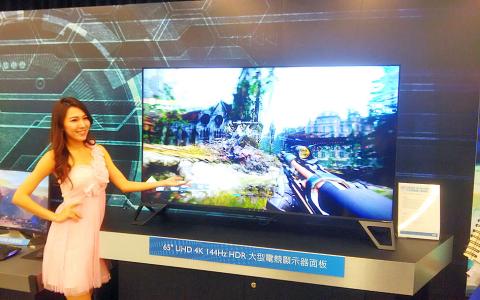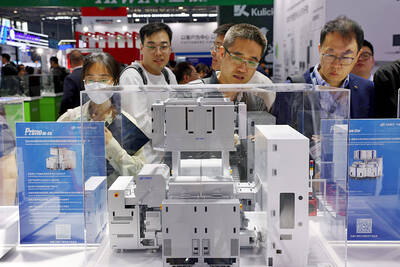AU Optronics Corp (AUO, 友達光電) yesterday said it is working with clients to offer flexible displays for their new foldable phones, likely later this year, an early sign that the industry is embracing such dual-screen phones for lack of major killer features.
That could be a breakthrough for the LCD panel maker, which has been supplying OLEDs for smaller devices, mostly wearables, in the past few years.
AUO’s remarks came after the world’s two biggest mobile phone companies — South Korea’s Samsung Electronics Co and China’s Huawei Technologies Co (華為) — recently showcased their latest foldable phones, the Galaxy Fold and Mate X respectively.

Photo: CNA
Such foldable phones “are a novelty that adopts display technologies in a new way and make such phones a new hybrid of mobile phones and tablets,” AUO chairman Paul Peng (彭双浪) told a media briefing.
“AUO has been putting resources in developing such displays. Hopefully we will see AUO’s flexible displays used in new foldable phones from branded vendors in 2019,” he said.
Unlike Huawei’s out-folding display, AUO has focused on in-folding displays, which have higher technological barriers, Peng said.
AUO plans to produce OLEDs at a 4.5-generation plant in Singapore for foldable phones, ordinary mobile phones and wearable devices.
Foldable phones are a “breakthrough,” but it remains to be seen how consumers will react to their high prices, and it would take time to see an uptake in such phones, Peng said.
The Galaxy Fold and Mate X have been priced at about US$2,000.
Samsung said the Galaxy Fold, which has a 7.3-inch main display and a 4.6-inch cover display, would reach stores next quarter.
New orders have started to trickle in after supply chain inventories were falling to healthy levels after the Lunar New Year holiday, and it has also received some orders that were shifted away from peers that have hit bottlenecks in boosting production, AUO said.
The order outlook for next quarter seems positive, which would push its factory utilization to almost 100 percent, it said.
AUO, which posted its first quarterly losses last quarter due to an overcapacity-driven industry slump, said oversupply would become a norm and it was increasing proportions of value-added products in its product lineup.
The value-added products, which include 85-inch ultra-high-definition 8K TV panels and flat panels for gaming PCs, would account for 50 percent of its revenue, AUO said.

With this year’s Semicon Taiwan trade show set to kick off on Wednesday, market attention has turned to the mass production of advanced packaging technologies and capacity expansion in Taiwan and the US. With traditional scaling reaching physical limits, heterogeneous integration and packaging technologies have emerged as key solutions. Surging demand for artificial intelligence (AI), high-performance computing (HPC) and high-bandwidth memory (HBM) chips has put technologies such as chip-on-wafer-on-substrate (CoWoS), integrated fan-out (InFO), system on integrated chips (SoIC), 3D IC and fan-out panel-level packaging (FOPLP) at the center of semiconductor innovation, making them a major focus at this year’s trade show, according

DEBUT: The trade show is to feature 17 national pavilions, a new high for the event, including from Canada, Costa Rica, Lithuania, Sweden and Vietnam for the first time The Semicon Taiwan trade show, which opens on Wednesday, is expected to see a new high in the number of exhibitors and visitors from around the world, said its organizer, SEMI, which has described the annual event as the “Olympics of the semiconductor industry.” SEMI, which represents companies in the electronics manufacturing and design supply chain, and touts the annual exhibition as the most influential semiconductor trade show in the world, said more than 1,200 enterprises from 56 countries are to showcase their innovations across more than 4,100 booths, and that the event could attract 100,000 visitors. This year’s event features 17

Germany is to establish its first-ever national pavilion at Semicon Taiwan, which starts tomorrow in Taipei, as the country looks to raise its profile and deepen semiconductor ties with Taiwan as global chip demand accelerates. Martin Mayer, a semiconductor investment expert at Germany Trade & Invest (GTAI), Germany’s international economic promotion agency, said before leaving for Taiwan that the nation is a crucial partner in developing Germany’s semiconductor ecosystem. Germany’s debut at the international semiconductor exhibition in Taipei aims to “show presence” and signal its commitment to semiconductors, while building trust with Taiwanese companies, government and industry associations, he said. “The best outcome

Semiconductor equipment billings in Taiwan are expected to double this year, as manufacturers in the industry are keen to expand production to meet strong global demand for artificial intelligence applications, according to SEMI, which represents companies in the electronics manufacturing and design supply chain. Speaking at a news conference before the opening of Semicon Taiwan trade show tomorrow, SEMI director of industry research and statistics Clark Tseng (曾瑞榆) said semiconductor equipment billings in Taiwan are expected to grow by an annual 100 percent this year, beating an earlier estimate of 70 percent growth. He said that Taiwan received a boost from a